FLANDERS’ MOST ADVENTUROUS CHOCOLATIER
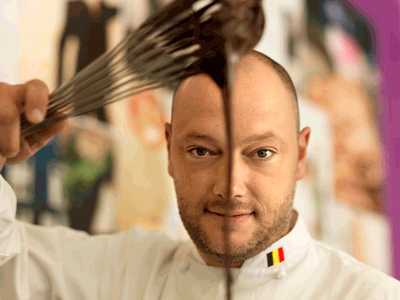
Text © 2012
Our tastes in food are closely connected to our childhood; what are your first memories of food?
DP: Food is my life. Anyone’s connection to food is influenced by their parents, their grandmothers. I think it’s very important to have your children taste all kinds of food, even if they don’t like it all. They don’t have to finish the portion, but should taste a little bit of everything because your memory is one big bank of flavors.
My first happy memory of food is my maternal grandmother’s carrots. I loved them. She cooked them on a big stove with a little bit of sugar, butter, thyme, and a little onion. I can still smell them. The recipe is called “Carrots Vichy.” Every Wednesday we went to her house and she cooked pork for all her grandchildren. My other grandmother made her own bread every Friday. She put the dough on a board to rise. I remember the dough covered with a napkin. We were forbidden to touch it. When she put it in the oven, the whole house filled up with this marvelous aroma.
Of chocolate?
DP: At Easter and on St. Nicholas day, the 6th of December. He looks like Santa Claus, but was a bishop. He brings presents for the children, toys, oranges, and, of course, chocolates in his shape and others. As a child it was very exciting to look for the chocolates. They were hidden all over the house. It was a treasure hunt. When I think about chocolate, I think about St. Nicholas. The chocolate was dark, milk, and white. Milk is usually the favorite when you are a child. The shapes could vary: St. Nicholas, a farmer, a football, a cow, a crocodile…
Why did you decide to become a chocolatier?
DP: That’s a long story. I’m not a real chocolate maker. I’m a cook. A long time ago, when I was thin and had long hair, I fell in love with chocolate. I went to cooking school. Then I went to Paris to learn more about cooking at a restaurant with 3 Michelin stars, so at the highest level. When I came back home, I decided that I was more excited about the pastry department in a restaurant where they made their own chocolates, than I was about starting my own restaurant. That’s how my career started. I use my training as a cook to create my chocolates. In the beginning, when I was concocting strange combinations for my fillings, a lot of people thought I was crazy, but now I make chocolates for “Hof van Cleve,” one of Flanders’ three restaurants with 3 Michelin stars. The filling is a jelly of griottes, a very acid cherry, and a ganache of Samba tea. I also make a chocolate for “Oud Sluis,” the no. 1 restaurant of The Netherlands; its filling is a caramel of Cabarnet Sauvignon vinegar and a praliné of pine nuts. I make chocolate for many of the best restaurants and chefs in Europe: Heston Blumenthal at “The Fat Duck,” the boys at “El Bulli”: Albert and Ferran Adrià are good friends of mine. René Redzepi has invited me to Copenhagen at the end of June. We’ll have lots of fun and create dishes together. Alex Atala (his “D.O.M.” in San Paolo, Brazil is no. 4 of the World’s 50 Best Restaurants this year) and I goof off a lot together. I learn a lot from those big-name chefs. In turn they get very excited by my knowledge of chocolate that I share with them. It’s a mutual growing process.

The Chocolate Line
I am one of the three chocolatiers to have three Michelin stars in the Guide Michelin. The other two are “Wittamer” in Brussels and “Del Rey” in Antwerp.
In the beginning, 15 years ago, I was making chocolates with wasabi, Havana cigars, fried onion, bacon, smoked salmon, grass from my garden, oysters, cauliflower, marzipan with a purée of black olives, white chocolate with fresh basil, chutney of sun-dried tomatoes. We are still making all of these, but 15 years ago chocolate lovers weren’t ready for those combinations. Little by little I became more and more appreciated by top chefs. Now in Belgium, without being vain, I am one of the most respected chocolatiers. I have my own TV show. I travel a lot hunting for my cocoa beans. Last year we went to Belize, Mexico, Guatemala, the Amazon, Peru, and Shilin. It was a lot of traveling. It’s wonderful though. Of course, it’s not just for fun; it’s work. In Peru, for example, we bought 12 tons of cocoa beans. Then we shipped it to Amsterdam and had to pick it up. It’s hard work, but it’s wonderful. I’m also the President of the Bruges Chocolate Guild. We are 52 chocolate makers here in Bruges. My nickname is the Kofi Anan of chocolates. When there’s a problem or a fight, I have to negotiate a peace agreement. I think it’s very important that we maintain our reputation here in Bruges as “the chocolate capital of Belgium.”
What are the steps for becoming a chocolatier? What advice would you give to a young person who told you he or she wanted to become a chocolatier?
DP: There are two big stories behind becoming a chocolatier. One is: learn the basics about cocoa beans. That’s why I go on my expeditions to find the best, and wrote my book: The Roots of Chocolate. It’s an account of my travels, adventures scouting out the best cocoa beans, even if there are some 30 recipes at the end. It’s the story behind chocolate. I put so much new information about chocolate on those pages. In 2009 it won the Gourmand World Cook Book Award for “The Best Chocolate Book of the World.” I had to do so many book presentations: in Rio de Janeiro, Tokyo, Prague… just to talk about my expeditions, so the variety of beans, the way we work with the beans; our respect for the farmers and for the forest is very important. That’s one part.
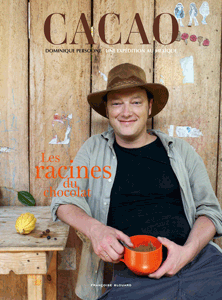
Cacao, Les racine du chocolate (Cacao, The Chocolate Routes)
Here in Europe you learn that there are three types of cocoa beans: Criollo, Forasteros, and Trinitario. I had a presentation in San Paolo in Brazil and I talked with a professor at the Chocolate University. Can you imagine a university devoted only to the study of chocolate? Amazing! He told me that only in the Amazon, from the border of Peru going down to Brazil, they’ve already discovered 24,000 different cocoa plants. Three times 24,000 just in the Amazon! Nobody thinks that by cutting down the Amazon forest we will also lose many of these varieties of cocoa beans. That breaks my heart. Everywhere there are two cocoa bean harvests a year, one in April and one in October. We separate the beans that are truly exceptional for their flavor. We don’t mix them with the others and we make origin chocolate from the exceptional beans. They come from Peru, Ecuador, Venezuela… That’s very important too.
My other passion is playing with flavors. For example, the ingredients of the chocolates we make for “Hertog Jan,” one of the two 3-star Michelin restaurants here in Bruges, include special olive oil and seaweeds. For Alex Atala, the no. 1 chef in Latin America, we made together small chocolate frogs, yellow frogs, the poisonous frogs of the Amazon, with a filling of chili, lemon, and coriander. Coriander is a typical flavor from the Amazon. The story behind this is the backpackers in the Amazon, the young guys, catch those frogs and they lick them. They’re poisonous so the backpackers are high for two days. So we made these frogs out of chocolate and put novacain, the product that dentists use, on them and the people who ate them couldn’t talk for one minute afterwards. With Heston Blumenthal from “The Fat Duck” I made a chocolate mousse with helium gas. As I recount in my book, I discovered an old recipe from the Mayan Indians: the more air you put in your chocolate drink (because the Mayans drank their chocolate and they still do in Latin America), the more the flavor of the cocoa beans is enhanced. So the chocolate started to fly. It was really really fun.
Do you train interns?
DP: Sure, my staff numbers 39 now. Ten years ago I opened this shop, ”The Chocolate line” here on Simon Stevin Square in Bruges with my wife, Fabienne Destaercke, and my mother-in-law who came to help us on the weekends. Now we number 39 in personnel, have two shops, this one in Bruges and we opened another two years ago on the Meir, the main elegant pedestrian shopping street in Antwerp and the most important shopping street in Belgium. It’s in the same palace where Napoleon lived. Half of the palace, which is a protected building, is ours now, the downstairs. The most amazing thing for me is that we still have Napoleon’s kitchen and there we make our chocolates now. We have the old stove, the old tiles, the old stonewalls. If I want to change something, I have to write twenty letters asking for permission. We have a box of chocolates with a Napoleon theme. It’s called “Who’s the Sweetest Girl?” The box has windows like an advent calendar. Behind one window is a bust of Napoleon and behind the others are busts of Napoleon’s wives and his different mistresses.
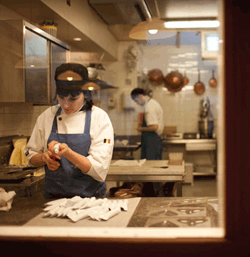
chocolatiers
Who were your mentors and what did you learn from them?
DP: My mother. She loved to cook. My mother had a passion for food. Even when she was old, two evenings a week she went to cooking school. Food is in our DNA. That’s for sure.
Other professional chocolatiers in your family?
DP: No, my father was the manager of the casinos at Middelkerke and Blankenberge on the coast, and there we had a nice restaurant with one Michelin star in the 1980s. I’m not “the son of the boss,” who does nothing. I started working on Friday after school, shelling peas, peeling potatoes, cleaning lobster. I learned “the food spirit” at that time. I’m a hard worker. I have a sister who’s a year older than me. Now she’s a tax inspector.

The chocolate artist
You studied chocolate making with French pastry chefs Pierre Hermé and Pascal Brunstein; what did you learn from them?
DP: The passion of working with chocolate, because chocolate is a very mysterious product. Of course fish is mysterious too, but fish you can touch. When as a chef you work with chocolate, the first times will be disasters: it burns; it smells bad; it gets sticky; it’s not shiny, so it makes you a little angry. You really have to be focused on what you are doing. Chocolate is mysterious and it grabbed my attention. What I like is the challenge to make perfect chocolates. Hermé and Brunstein are VIP pastry and chocolate chefs in France and it was an honor for me to work with them. I learned the basics from them and to be satisfied only if I had the perfect result. I also learned to work very hard from both of them and to never look at my watch. I worked 16 hours per day. Now, once I’ve perfected a recipe, I don’t stay in my laboratory to make it. I work on other aspects of the profession.
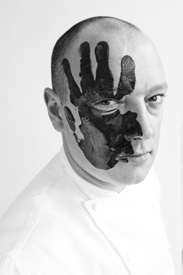
What are the essential qualities of a top chocolatier?
DP: Imagination, creativity, never to be satisfied, to be very open-minded, to do many presentations. I do lots of presentations about food and emotion. For example, if you eat an oyster in a restaurant or if you eat it on the beach, the one you eat on the beach tastes much better because you smell the ocean air and hear the waves banging on the shore. I also make lots of funny things like the “chocolate shooter” or a chocolate sniffer I made for Mick Jagger’s birthday, chocolate lipsticks, chocolate paint, and chocolate massage cream. I work with scientists. I think this is very important. One of my friends, Bernard Lahousse, whose company is called “Sense for Taste” told me that chocolate contains a love hormone, a happy hormone, the same hormone that leaves our brains when we have an orgasm. I wanted to make little Valentine hearts with an overdose of the love hormone; then we blocked the affects of this love hormone with Chinese pepper until our chocolate was perfected. You can only eat ten grams. It’s very strong, but when you eat it, you cannot walk, you’re very loopy, very happy. I’m so passionate about chocolate that I want to try all the things that are possible to make with it. I cannot sell the valentine hearts in the shop; it’s too dangerous, too kinky; it’s the same hormone used in Prozac, prescribed to people who are depressed.
How would you define your style?
DP: Open-minded. The people who taste my chocolates must also be open-minded towards my different fillings. They must not decide before tasting an unusual one that it will be disgusting, because, if they taste it with a preconceived negative judgment, it will be disgusting. Never judge before you taste something. We are very spoiled in the developed world. Don’t take everything seriously. I love to joke. You can tell that from some of my inventions. For example, last year I made a dessert called “Chocolate Magic Mushrooms”: chocolate with smoked ice and liquid oxygen; it was something out of Alice in Wonderland.
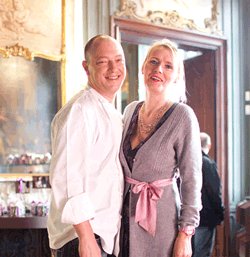
Persoone and his wife
What do you like best about your work?
DP: Creativity and meeting so many fascinating people. I’m sure that food is the most wonderful thing in the world. If you have it, it usually makes you happy.
The least?
DP: Paperwork. Luckily for me, my wife, she’s Aquarius, is the big boss and she takes care of our administration. There’s a lot of paperwork with a staff of 39. Every week, she gives me “drink money” like my mother used to do. This system works perfectly. I also have a personal assistant; she has my agenda so every day she tells me what I have to do. Otherwise I’d be totally disorganized.
I hate TV work, but I have to do it for exposure. I have two kinds of programs. In one they follow me on my expeditions to the jungles of Central and South America. That’s OK. The other is cooking my recipes. When I do that for one, two, or three programs, that’s OK too, but, when we do a series sometimes for one week, I get bored.
What’s your chocolatier philosophy?
DP: The most important of all is starting by looking for a good base: the beans. My friend the scientist Bernard Lahousse has a great website: www.foodpairing.be. It’s free. Do you know about food pairing? It’s scientific research into the flavor molecules that make up various foods. They can see, for example, that oysters have the same flavor molecules as kiwis so that means you can make a dish with oysters and kiwis. The same is true for strawberries and peas. The chocolate of Peru has the same flavor molecules as roasted chicken and blue cheese. So when I make my combinations, these flavors will match and everything will be perfect.
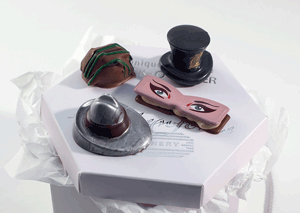
Persoone’s whimsical chocolate creations
What are your signature chocolates?
DP: All my chocolates are listed on the website. We have four websites. One is on the book; one about me; one about the company, and one on the “chocolate shooter.” Perhaps my “tequila choc-tail” is my signature chocolate.
Do you have a favorite chocolate?
DP: Every day my favorite changes. It depends on the mood of my day. Take this green one. It’s passion fruit, green lemon, and vodka. I hate fake flavors so it’s really done with the juice of passion fruit, the skin of green lemon, chocolate from Ecuador. For me it’s very refreshing even if some people will hate it because it’s so acidic. That’s where my privilege of being a chef and not a pastry chef comes in. Normally if you go into the chocolate business, your basis is baking and pastry, and then you get a specialization in chocolate. For those colleagues, their most important tool is their scales, weighing all the ingredients. As a cook the most important utensil for me is a spoon. You taste, then taste, then taste… I try to find the perfect balance of taste for all my ingredients. My use of taste is my strength.
I have no idea what my biggest sellers are. Honestly. Chocolate is seasonal. All I know is that TV promotion is very important. When I say something on TV, the day after everyone wants it.
How many new chocolates do you create?
DP: Way too many. My wife is always angry. She brings me down to earth, reality every so often. My dream is to work like the philosophy of a restaurant and to follow the seasons, to change according to the seasons of the year. This month we made wonderful chocolates with asparagus. Then in the summer time we have lots of different fruits. Then in the autumn we can make wonderful chocolates with wild mushrooms and with octopus. All 39 of us taste a new creation. Everybody’s opinion is important. The other 38 are like our first customers.
Where can you buy your chocolate outside this shop and your new one in Antwerp?
DP: Nowhere.
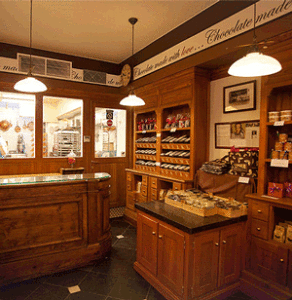
Interior of The Chocolate Line
Besides your candies, you make a chocolate lipstick, chocolate block letters, chocolate dog shit, and have invented the chocolate shooter, anything else?
DP: Chocolate paint. I worked with Spencer Tunick, the photographer. He’s from New York, but he takes pictures all over the world of hundreds of naked bodies. He’s had exhibitions in Paris, London, Amsterdam, the Taj Mahal. He asked me to make a chocolate paint because he wanted to do an installation of naked ladies covered with chocolate in Bruges. Finally we made it. Everybody laughed, but it sells like crazy. It works on paper too.
The show was such a success that Tunic wanted to do another installation only with guys. This time I made white chocolate paint and asked my wife to put it on the guys. I did the girls; she did the guys. Like the sniffer, the paints start as a laugh, but become bestsellers. When I made the sniffer for the Rolling Stones, everyone said “Dominique, you are crazy, they will never use it.”
Tell me more about the chocolate shooter?
DP: It’s a little machine. So instead of putting various chocolates on a dish, I let you sniff chocolate. So you have chocolate on your brain, and taste chocolate without eating any. The first machine we made ourselves—very small. We went to the market and bought some plastic. The day after the party the Rolling Stones gave an interview and, of course, were asked about what went on at the party. “Yeah,” they said, “we sniffed chocolate from “Chocolate Line.” And now we’ve sold more than 10,000 sniffers. It costs 45 euros. It’s a box with two flavors you can sniff three hundred times, plus the machine. It started as a joke.
What are the reasons for your success?
DP: My sense of humor. No doubt about it. One month ago I had a presentation at TED, an American non-profit devoted to ideas worth spreading. You go on stage and they give you 18 minutes and you have to explain your philosophy. I talked about the connection between food and emotion.
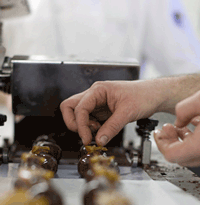
Your next big project?
DP: I’m building my new chocolate factory, which will be 2800 square meters, so really big. On top floor we will have a big test kitchen and on the roof a green house with an herb garden.
Other Belgian chocolatiers that you admire?
DP: Del Rey in Antwerp, Pierre Marcolini. He’s a French-speaking Belgian and I’m Flemish so the press tries to create a rivalry between us, but we love each other. He’s a great colleague. There’s space for everybody. He has another philosophy. My book, Roots of Chocolate and his new book were one competitors in the Gourmand Cook Book Awards. Mine won and he was a little angry, but I have a lot of respect for him.
Non-Belgian chocolatiers that you admire?
DP: In Paris you have a great one, Patrick Roger. In Italy you have wonderful chocolate makers too: Domori, Amadei, De Bondt in Pisa.
You wrote your book “Roots of Chocolate” about the history of chocolate and your adventures looking for cocoa beans in Mexico. Do you ever lead chocolate tours for chocoholics?
DP: I did it once with my wife and then she said: “Never again.” It’s quite dangerous where I go. It’s not touristic. Some of the animals are dangerous, but so are some of the Indian tribes. For example, if you go into one of their camps and a baby dies, they could easily say it’s because a white man came here. They are very religious. The problem with chocolate is cocoa and cocaine. Colombia, Guatemala, and Venezuela are all very dangerous. I have to take care of myself and that’s a big job. We normally travel in six. I’m the oldest and the only one from my staff here in Bruges. I go with Eddy Van Belle, the owner of the chocolate museum, “Choco-Story” here in Bruges. The rest of the team is listed in the book.
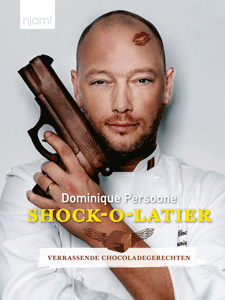
You have just published a new book “Shock-O-Latier in March 2012; is it an autobiography?
DP: Yes, but so far it’s only been published in Flemish. It includes recipes for children.
Up to now you’ve told me about Dominique Persoone the chocolatier; I’d like to know more about Dominique Persoone the person. For example, what are your favorite foods? Favorite chocolates?
DP: My favorite food changes every day as well. I like Japanese food. I also have a very good Italian friend, Peppe, who has a delicious restaurant here in Belgium called “La Botte” in Genk. It’s a two hours drive from here. On special occasions my wife makes me Zurkelpatajes met worst, the way my grandmother and my mother used to make it. It’s mashed potatoes with a kind of spinach, except it’s very sour like lemon, and sausage.
As for chocolate, every six months you have a new harvest so each one is different. This year Papua New Guinea and Peru are wonderful. When you talk about fillings, now the passion fruit, lemon, and vodka, is refreshing or the caramel of the cabernet of Sauvignon vinegar and praliné of pine nuts and the griottes with a ganache of Samba tea.
A dish you dislike?
DP: I’m not into insects. I’ve tasted them in South America, but I don’t say “Wow! What a great flavor!”
A chocolate you don’t like?
DP: There are some qualities that I don’t like, sure. With all due respect, in the States you have a lot of fake chocolate; it’s not nice to eat. Sorry, but it’s not very good quality. That’s a pity.
Your favorite dessert?
DP: “Chocolate Monkey Brains”—it’s a new dessert. I’m making it for the annual Food Festival we will hold here in Bruges in September this year. It’s a chocolate head of a monkey and with a spoon you have to crack it open and eat the brains made of coconut mousse with a pearl of strawberries, so it’s sour and quite liquid, and caramel of pineapple inside. I think it’s important that whatever you make should have a liquid, something crunchy, something sweet, something sour, and then you can start playing with it. The structure is very important.
A dessert you don’t like?
DP: Not really. For me it’s quality that matters. When something is cheaply made, or ready-made, or stupidly made, then I don’t like it. I love carrot pie, cherry pie, vanilla ice cream as long as it’s well made. I hate some vanilla ice creams; some of the carrot pies I really hate, but it has nothing to do with the name of the dessert.
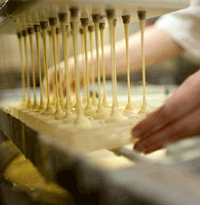
white chocolate
Your favorite spice?
DP: Coriander.
Your favorite color?
DP: Purple. The floor of my new factory is purple.
What zodiac sign are you?
DP: Libra. My birthday is the 24th of September, 1968.
Chefs are well known for having collections, often of motorcycles, fast cars, or watches; what about you?
DP: I had a problem with my very old and ugly car and the mechanic at the garage said: “Dominique, can I be very honest? Normally I only have this problem sometimes with women drivers, so can I be honest? Dominique, you should know that you not only have to fill up the tank with gas, but sometimes you also have to change the oil.” I know nothing about cars. I hate cars. I know nothing about sports, soccer or cycling. I’m not a real man in that sense. I’m just focused on food. However, I do have a collection of machetes. Each time I go on a cocoa bean expedition, and it’s fourteen so far, I buy a new local one. Then I try to exchange it with a local farmer for an old one. He is very happy to have a new one and I’m very happy to have an old one. An old machete is a souvenir of each expedition. They are the only thing I collect.
Where do you like to go on vacation?
DP: My wife loves the sun. Every year we go to the Canary Islands for Christmas and New Year’s. I promised her though that this summer we will go to Italy.
Your hobbies?
DP: I have three dogs. We live in the country so we have lots of chickens, a garden, fruit trees.
If you hadn’t become a chocolatier, what profession would you have chosen?
DP: Definitely something connected to food. Some people say I would be a good teacher. I like to communicate.
& & &
